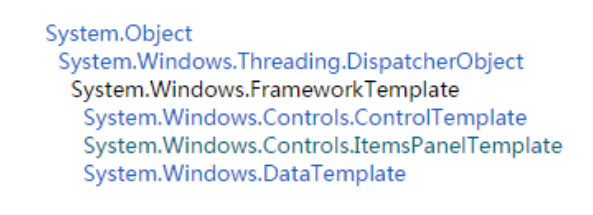WPF源代码分析系列一:剖析WPF模板机制的内部实现(一)
众所周知,在WPF框架中,Visual类是可以提供渲染(render)支持的最顶层的类,所有可视化元素(包括UIElement、FrameworkElment、Control等)都直接或间接继承自Visual类。一个WPF应用的用户界面上的所有可视化元素一起组成了一个可视化树(visual tree),任何一个显示在用户界面上的元素都在且必须在这个树中。通常一个可视化元素都是由众多可视化元素组合而成,一个控件的所有可视化元素一起又组成了一个局部的visual tree,当然这个局部的visual tree也是整体visual tree的一部分。一个可视化元素可能是由应用直接创建(要么通过Xaml,要么通过背后的代码),也可能是从模板间接生成。前者比较容易理解,这里我们主要讨论后者,即WPF的模板机制,方法是通过简单分析WPF的源代码。由于内容较多,为了便于阅读,将分成一系列共5篇文章来叙述。本文是这一系列的第一篇,重点讨论FrameworkTemplate类和FrameworkElement模板应用机制,这也是WPF模板机制的框架。
一、从FrameworkTemplate到visual tree
我们知道尽管WPF中模板众多,但是它们的类型无外乎四个,这四个类的继承关系如下图所示:

可见开发中常用的三个模板类都以FrameworkTemplate为基类。问题是,除了继承关系,这些模板类的子类与基类还有什么关系?三个子类之间有什么关系?这些模板类在WPF模板机制中的各自角色是什么?WPF究竟是如何从模板生成visual tree的?
要回答这些问题,最佳途径是从分析模板基类FrameworkTemplate着手。
FrameworkTemplate是抽象类,其定义代码比较多,为了简明,这里就不贴完整代码了,我们只看比较关键的地方。首先,注意到这个类的注释只有一句话:A generic class that allow instantiation of a tree of Framework[Content]Elements,意思是这个类是允许实例化一个Framework元素树(也即visual tree)的基类(generic class),其重要性不言而喻。浏览其代码会发现一个值得注意的方法ApplyTemplateContent():
****************FrameworkTemplate******************
// // This method // Creates the VisualTree // internal bool ApplyTemplateContent( UncommonField<HybridDictionary[]> templateDataField, FrameworkElement container) { ValidateTemplatedParent(container); bool visualsCreated = StyleHelper.ApplyTemplateContent(templateDataField, container, _templateRoot, _lastChildIndex, ChildIndexFromChildName, this); return visualsCreated; }
这是删除了打印调试信息后的代码,简单到只有三个语句。注释表明FrameworkTemplate生成VisualTree用的就是这个方法。其中最重要的是第二句,它把具体应用模板内容的工作交给了辅助类StyleHelper.ApplyTemplateContent()方法。这个方法的注释是:Instantiate the content of the template (either from FEFs or from Baml).This is done for every element to which this template is attached。其意思是说,每一个带有模板的元素要实例化模板的内容(无论是来自FEF还是来自Baml),都必须调用这个方法。而查看对StyleHelper.ApplyTemplateContent()方法的引用,会发现它只被引用了一次。而这唯一一次引用就是在FrameworkTemplate.ApplyTemplateContent()方法里。这也表明这个方法是FrameworkTemplate生成visual tree的唯一入口。
由于StyleHelper.ApplyTemplateContent()方法的代码较多,这里为了简洁就不贴了。简而言之,这个方法会视具体情况选择合适的方法来实例化一个FrameworkTemplate,用其生成一个visual tree。生成的visual tree最终都会被传递到FrameworkElement.TemplateChild属性上,而这个属性的setter又会调用Visaul.AddVisualChild()方法。后者的主要目的建立两个visual之间的父子关系(parent-child relationship),以方便以后进行布局(layout)。至此,一切准备就绪,生成的visual tree已经可视化了。
*****************FrameworkElement*******************
/// <summary> /// Gets or sets the template child of the FrameworkElement. /// </summary> virtual internal UIElement TemplateChild { get { return _templateChild; } set { if (value != _templateChild) { RemoveVisualChild(_templateChild); _templateChild = value; AddVisualChild(value); } } }
由于FrameworkTemplate.ApplyTemplateContent()不是虚方面,因此其子类无法覆写。查看这个方法的引用我们可以看到,这个方法只在FrameworkElement.ApplyTemplate()里被调用了一次,这意味着FrameworkElement的这个方法是FrameworkElement及其子类实现模板应用的唯一入口。这个方法的重要性无论如何强调都不为过,以后我们还会多次提到这个方法。因此有必要贴一下其代码:
//***************FrameworkElement********************
/// <summary> /// ApplyTemplate is called on every Measure /// </summary> /// <remarks> /// Used by subclassers as a notification to delay fault-in their Visuals /// Used by application authors ensure an Elements Visual tree is completely built /// </remarks> /// <returns>Whether Visuals were added to the tree</returns> public bool ApplyTemplate() { // Notify the ContentPresenter/ItemsPresenter that we are about to generate the // template tree and allow them to choose the right template to be applied. OnPreApplyTemplate(); bool visualsCreated = false; UncommonField<HybridDictionary[]> dataField = StyleHelper.TemplateDataField; FrameworkTemplate template = TemplateInternal; // The Template may change in OnApplyTemplate so we'll retry in this case. // We dont want to get stuck in a loop doing this, so limit the number of // template changes before we bail out. int retryCount = 2; for (int i = 0; template != null && i < retryCount; i++) { // VisualTree application never clears existing trees. Trees // will be conditionally cleared on Template invalidation if (!HasTemplateGeneratedSubTree) { // Create a VisualTree using the given template visualsCreated = template.ApplyTemplateContent(dataField, this); if (visualsCreated) { // This VisualTree was created via a Template HasTemplateGeneratedSubTree = true; // We may have had trigger actions that had to wait until the // template subtree has been created. Invoke them now. StyleHelper.InvokeDeferredActions(this, template); // Notify sub-classes when the template tree has been created OnApplyTemplate(); } if (template != TemplateInternal) { template = TemplateInternal; continue; } } break; } OnPostApplyTemplate(); return visualsCreated; }
方法的注释表明FrameworkElement在每次measure时都会调用这个方法,而我们知道measure和arrange是UIElement进行布局的两个主要步骤。如果FrameworkElement元素在布局其HasTemplateGeneratedSubTree属性为false,那么就将调用FrameworkTemplate.ApplyTemplateContent()重新应用模板,生成visual tree。
这个方法的代码并不复杂,它先是调用虚方法OnPreApplyTemplate();然后如果HasTemplateGeneratedSubTree为false且TemplateInternal非空,则调用TemplateInternal的ApplyTemplateContent()方法生成相应的visual tree,并调用虚方法OnApplyTemplate()(这个虚方法在开发自定义控件时经常需要重写,此时visual tree已经生成并可以访问了);最后调用虚方法OnPostApplyTemplate()完成收尾工作。
从上面的分析可以看到,FrameworkElement能生成什么样的visual tree,或者说生成的visual tree的结构,完全取决于其TemplateInternal。给这个属性一个什么样的模板,就会生成一个什么样的visual tree。换句话说,FrameworkElement的visual tree的模板完全是由TemplateInternal唯一提供的。那么这个神奇的TemplateInternal属性又是怎如何定义的呢?事实上,除了这个属性FrameworkElement还定义了一个FrameworkTemplate类型的属性TemplateCache。这两个属性的定义都很简单,代码如下:
//***************FrameworkElement********************
// Internal helper so the FrameworkElement could see the // ControlTemplate/DataTemplate set on the // Control/Page/PageFunction/ContentPresenter internal virtual FrameworkTemplate TemplateInternal { get { return null; } } // Internal helper so the FrameworkElement could see the // ControlTemplate/DataTemplate set on the // Control/Page/PageFunction/ContentPresenter internal virtual FrameworkTemplate TemplateCache { get { return null; } set {} }
可以看到二者的注释几乎都完全相同,也都是虚属性,FrameworkElement的子类可以通过覆写它们来实现多态性,提供自定义的模板。它们的自定义模板完全决定了它们的visual tree。事实上,利用工具我们可以看到只有4个FrameworkElement子类重写了TemplateInternal属性:Control、ContentPresenter、ItemsPresenter、Page,这意味着只有这4个类及其子类调用ApplyTemplate()才有意义。
现在问题是:FrameworkElement的子类具体是如何通过覆写虚属性TemplateInternal来自定义模板的呢?FrameworkTemplate的三个子类的变量有哪些?它们在这个过程中的角色又有何不同?
为了便于理解,下面我们将按照三个模板子类,分成四篇文章来讨论(由于DataTemplate的内容较多,被分成了两篇文章)。
(本文是系列文章《剖析WPF模板机制的内部实现》的第一篇,查看下一篇点这里)
(原创文章,欢迎批评指正,转载请注明出处,谢谢!)



 浙公网安备 33010602011771号
浙公网安备 33010602011771号